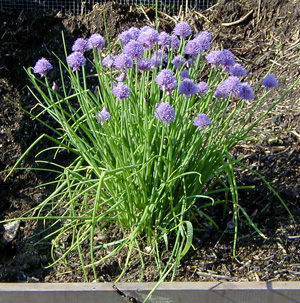
Chives, Allium schoenoprasum, is a species in the lily family (Liliaceae) that is native to Europe and Asia (and possibly North America, but there is some dissention on whether it is truly native or naturalized there). It has been cultivated in Europe since the Middle Ages, both for culinary and medicinal purposes, and as long as 4,000 years ago by the Chinese. Today the leaves are typically used as a culinary herb with a mild onion flavor. This plant, hardy to zone 3, is related to garlic chives (A. tuberosum), a perennial with brighter green, flatter and more angular leaves and white flowers in the fall. That plant has larger bulbs and a more pronounced garlic flavor. It can be used just like regular chives.
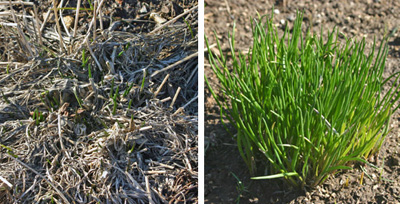
This species is an herbaceous perennial. The plant grows in dense clumps of slender bulbs, each bulb producing hollow tubular leaves 8-20 inches long. The soft-textured, blue-green leaves emerge in spring before the plant blooms and will continue to produce new leaves throughout the growing season so the plant remains fresh-looking. In mild climates the plants may remain evergreen but in cold climates the foliage is killed over the winter. Old plant remains should be removed in late winter before growth resumes in early spring.
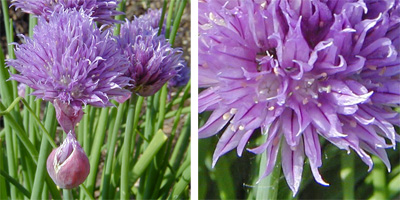
Chives bloom in mid spring to early summer. Each inflorescence is surrounded by a papery bract that splits open at flowering. The pink to pale purple round globes are composed of many small, tightly packed, star-shaped florets. The inflorescence typically has 10-30 individual flowers each with six tepals. The flowers are attractive to pollinators and are frequently visited by bumblebees and other types of bees. Pollinated flowers produce small angular black seeds that are enclosed in a small, three-valved capsule. Chives may self-seed readily but deadheading after the flowers fade will reduce or eliminate volunteer seedlings.
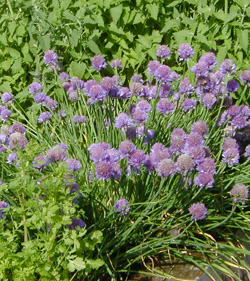
Chives are one of the easiest herbs to grow. They do best when planted in full sun in rich, well-drained soil, although they will tolerate light shade (flowering may be reduced) and most soil types. They are easy to grow from seed or from divisions. Seeds can be started indoors a few weeks before the average date of last frost to be planted outside after the danger of frost is past, or can be direct seeded once the soil is warm. Space the clumps 12-20 inches apart. Since they are fairly shallow-rooted be careful when cultivating around the plants – or mulch for weed control. Chives are drought tolerant once established, although they will grow best when given consistent moisture. They have low nutrient requirements, so do not need regular fertilization. Plants should be divided every 2-3 years to prevent overcrowding. Divisions should include at least 5 bulblets. Chives have no significant insect or disease problems and are not favored by deer or rabbits.
There are a number of cultivars of chives, including some dwarf or taller types, although they may not be readily available.
- ‘Album’ is a white flowered form
- ‘Curly Mauve’ has prostrate foliage that curls in different directions and has gray-lavender flowers held erect above the short curled foliage.
- ‘Forescate’ is larger than the species, growing 18-20″ tall and with larger, brighter flowers.
- ‘Marsha’ is a very deep purple form.
- ‘Pink Giant’ is taller than other types, with leaves about twice the size of the species, and large, clear pink blossoms.
- ‘Profusion’ is a sterile form that flowers over a longer period than the species.
- ‘Snowcap’ is a dwarf white-flowered cultivar.
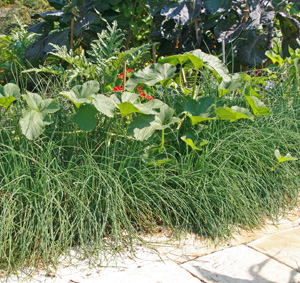
Chives are typically grown in the herb or vegetable garden but can also be incorporated in more ornamental settings. The grass-like foliage provides good contrast in texture and form to mounding perennials with coarser foliage, while the attractive flowers offer nice color when in bloom. They can be used to edge beds or borders, or can be used as accent plants alone or in masses (depending on the size of the planting). Chives would combine nicely with columbine, late-blooming tulips, and other late spring bloomers or with creeping thyme in a rock garden. Try combining small clumps in containers with ornamentals or other culinary herbs, such as basil and parsley, for a container herb garden. Flowers can be dried to use in ornamental arrangements, although the color of the petals will not be as bright as when fresh. Small clumps can be potted up and moved indoors in the fall to grow in a bright windowsill through the winter to supply fresh leaves during the cold months.

Chives can be harvested any time during the growing season after the leaves are about 6″ long, although the older leaves will be tougher than the new ones. The flavor will be more pungent in hotter weather. Plants can be cut back to about 3″ high after flowering to force the plant to produce new, tender leaves. When harvesting, cut as you need chives, selecting just some of the leaves in a clump each time for continuous harvest through the season. If the entire clump is cut back it will take several weeks for the leaves to regrow. Use only turgid, green leaves (without yellow tips or any browning or wilting). Snip with scissors or use a knife to cut the leaves about 2″ from the base. They can be used immediately or stored under refrigeration for up to a week. Chives can also be frozen or dried for later use, but the leaves lose a lot of their flavor when dried.
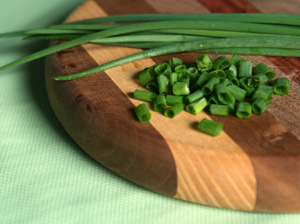
The leaves are often chopped into small segments to be used as seasoning or garnish sprinkled on the food just before serving. The flowers are edible as well.
– Susan Mahr, University of Wisconsin – Madison





 Aster, Symphyotrichum spp.
Aster, Symphyotrichum spp. Fascinating Fasciation
Fascinating Fasciation Alternatives to Lawn: Groundcovers
Alternatives to Lawn: Groundcovers Marigolds
Marigolds


